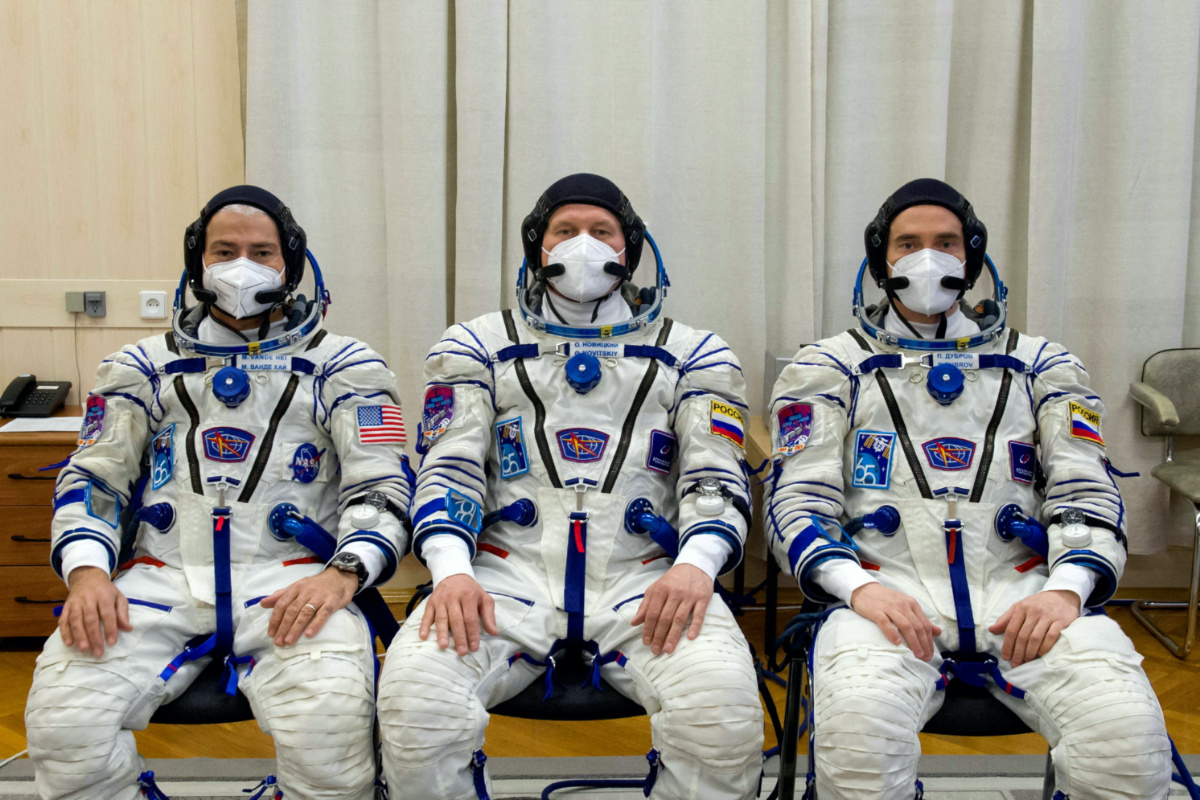A US astronaut is still slated to share a ride back from the International Space Station with two cosmonauts aboard their Soyuz capsule later this month, despite US-Russian antagonism over the war in Ukraine, NASA officials said on Monday.
Joel Montalbano, manager of NASA’s International Space Station program, also said US-Russian cooperation aboard the orbital research outpost, currently home to four Americans, two Russians, and one German from the European Space Agency, remained free of tension.

The International Space Station crew members Mark Vande Hei of NASA, cosmonauts Oleg Novitskiy and Pyotr Dubrov of Roscosmos are pictured during space suit check at the Baikonur Cosmodrome, Kazakhstan on 9th April, 2021. PICTURE: Irina Spector/GCTC/Roscosmos/Handout via Reuters.
“We both need each other to operate the International Space Station,” Montalbano told a news briefing on two upcoming ISS spacewalks by NASA crew members, the first of which was to begin on Tuesday.
The durability of longstanding US-Russian collaboration in space was called into question last month when Dmitry Rogozin, head of Russia’s space agency, Roscosmos, suggested US sanctions imposed against Moscow over the Ukraine crisis could “destroy” ISS teamwork and lead to the demise of the space station itself.
When US President Joe Biden announced high-tech export restrictions on President Vladimir Putin’s government on 24th February, he said they were designed to “degrade” Russia’s aerospace industry, including its space program.
A week later, Moscow retaliated by announcing it would stop supplying or servicing Russian-made rocket engines used by two American aerospace companies doing business with NASA.
At about the same time, Moscow said it had ceased joint ISS research with Germany and forced the 11th-hour cancellation of a satellite launch British broadband company OneWeb had planned to conduct from Russia’s Baikonur Cosmodrome in Kazakhstan.
Rogozin also said last month Roscosmos was suspending its cooperation with European launch operations at the European Spaceport in French Guiana.
Asked whether escalating geopolitical tensions over Putin’s invasion of Ukraine, which Russia calls a “special military operation”, might spill over to undermine morale or US-Russian cooperation on the space station, Montalbano insisted ISS “interdependency” between the two former space rivals remains firmly intact.
“When you’re in space, there’s no borders. You don’t see country lines or state lines,” Montalbano told reporters. “The teams continue to work together. Are they aware of what’s going on on Earth? Absolutely. But the teams are professional,” he added. “They’ve trained to do a job, and they’re going to do that job.”
NASA astronaut Mark Vande Hei, who flew to the orbital outpost aboard a Russian Soyuz spacecraft launched last April from Baikonur, is due to return to Kazakhstan on 30th March in a different Soyuz craft with cosmonaut peers Pyotr Dubrov and Anton Shkaplerov.
Montalbano said Roscosmos had recently confirmed “Mark Vande Hei is coming home March 30 with Anton and Pyotr, period.”
We rely on our readers to fund Sight's work - become a financial supporter today!
For more information, head to our Subscriber's page.
Logging a NASA record-breaking 355 days in orbit by the time he returns, Vande Hei will be greeted in Kazakhstan by a team of about 20 NASA personnel flying into the former Soviet republic for the homecoming as they have for previous ride-sharing liftoffs and landings by US astronauts over the years, Montalbano said.
The new three-member cosmonaut team replacing Vande Hei, Dubrov and Shkaplerov aboard the ISS is expected to arrive on the orbiting laboratory on 18th March as planned, Montalbano added.
He said NASA was also still in talks with Roscosmos on a new “crew exchange” deal that would pave the way for astronauts and cosmonauts to routinely share flights to the space station on each other’s spacecrafts.
NASA began paying to fly its astronauts to ISS aboard Soyuz after the US space shuttle ended in 2011, only resuming launches from US soil aboard SpaceX rockets over the past two years. None of those crews have included cosmonauts.





